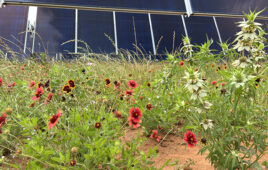By Erik Lensch, CEO, Leyline Renewable Capital
The solar industry has been used to a certain amount of baseline uncertainty over the past few decades. From federal tax credit fluctuations to net metering and module tariff debates, there is never a dull moment. At first glance, it might be easy to feel pessimistic about the solar industry in 2022. After over a decade of decreasing costs, the solar industry experienced the first year of increased pricing in 2021.
But the truth is that the biggest issues facing developers at the moment are temporary ones. Supply chain disruptions caused by the Coronavirus pandemic will eventually be resolved. The renewable energy industry has never been stronger in terms of public and political support. Inflationary pressure and delays will cause some projects to fail in the short-term, although those with the right capital will be able to ride the storm.
How can developers ride this storm to better times? In this article, we look at the impact this uncertainty is causing on developers and the options available to maximize returns.
A rise in cost and uncertainty for developers
Beyond the existential crisis for many solar industry firms caused by the solar module trade case, the overall impact of these issues is a rise in cost and uncertainty across the entire solar value chain. Project development is taking longer than expected, impacting cash flows for developers large and small. The end result is that some developers are making moves to sell projects earlier than expected to get whatever gains they can before cash reserves are depleted or returns are completely lost.
Unfortunately, uncertainty leads to fear and that fear is leading to a panic in the industry. Here’s a summary of the issues and their implications in the market for developers:

Assessing developer options
Developers actually have a variety of options when considering how to approach the current market situation. Some may consider selling assets as quickly as possible to generate cash. Others will take equity investments to generate both development and working capital to keep projects alive and employees paid. Some may borrow debt to cover a mix of expenses. The reality is that every option has advantages and disadvantages.
Option 1: Sell Assets
The first option that comes to mind during a period of uncertainty is to simply sell assets to generate cash. We are aware of developers that are already actively finding buyers, and it is likely that an abundance of supply is creating a buyers’ market. This results in a lower return on investment due to both market uncertainty and the fact that projects are being sold earlier than they would be otherwise. When projects are earlier in the development process, they are simply worth less. For some developers without the capital or desire to ride the storm, this may seem like the best option.
Option 2: Equity Investment
Instead of selling projects, some developers will consider taking equity investments in their companies to generate cash reserves to outlast the current market uncertainty. This capital would then carry project assets further along in the development process, creating more value and higher returns. The downside of an equity investment is a loss of control and a share of future returns. For many business owners, this can be difficult to accept after years of hard work.

Option 3: Increase Debt
Any business may consider borrowing money to cover costs until assets are sold and revenue is received. Solar developers are no stranger to this option as it can be very useful for short periods of time. The problem is that it is unknown how long the current market uncertainty will last. Moreover, having debt on the balance sheet will directly impact a company’s valuation for a future equity raise.

Option 4: Non-Dilutive Capital
There is also another option for developers in the form of non-dilutive capital. This option is in some ways a blend of equity and debt, but it hinges on specific projects instead of the parent company. Essentially, a financier will provide development or working capital to a developer, and the financier will receive repayment via proceeds from the projects when they are sold. In this situation, both the risk and reward for a project or a portfolio are shared by both parties.
This option is especially well suited for developers facing the impact of rising prices and project delays in the current market environment. With the right capital, developers can hold onto projects longer to maximize returns and ride through the storm of major issues.
Conclusion
Despite the headwinds, there is still reason to be optimistic about the solar industry’s future as public and private entities push to meet ambitious clean energy targets. Climate change is an ongoing threat, and organizations around the world have renewable energy procurement goals that they need to meet. The global economy is still recovering from the coronavirus pandemic to resolve inefficiencies and catch up with demand. The solar industry has faced trade disputes and existential policy challenges before and still pushed forward.
While this is good news for the long-term, developers are still facing the consequences of increased costs and project delays. Like any market sell off, there will be winners and losers. We believe that those with the right capital to outlast the market turbulence will reap rewards down the line.







Tell Us What You Think!